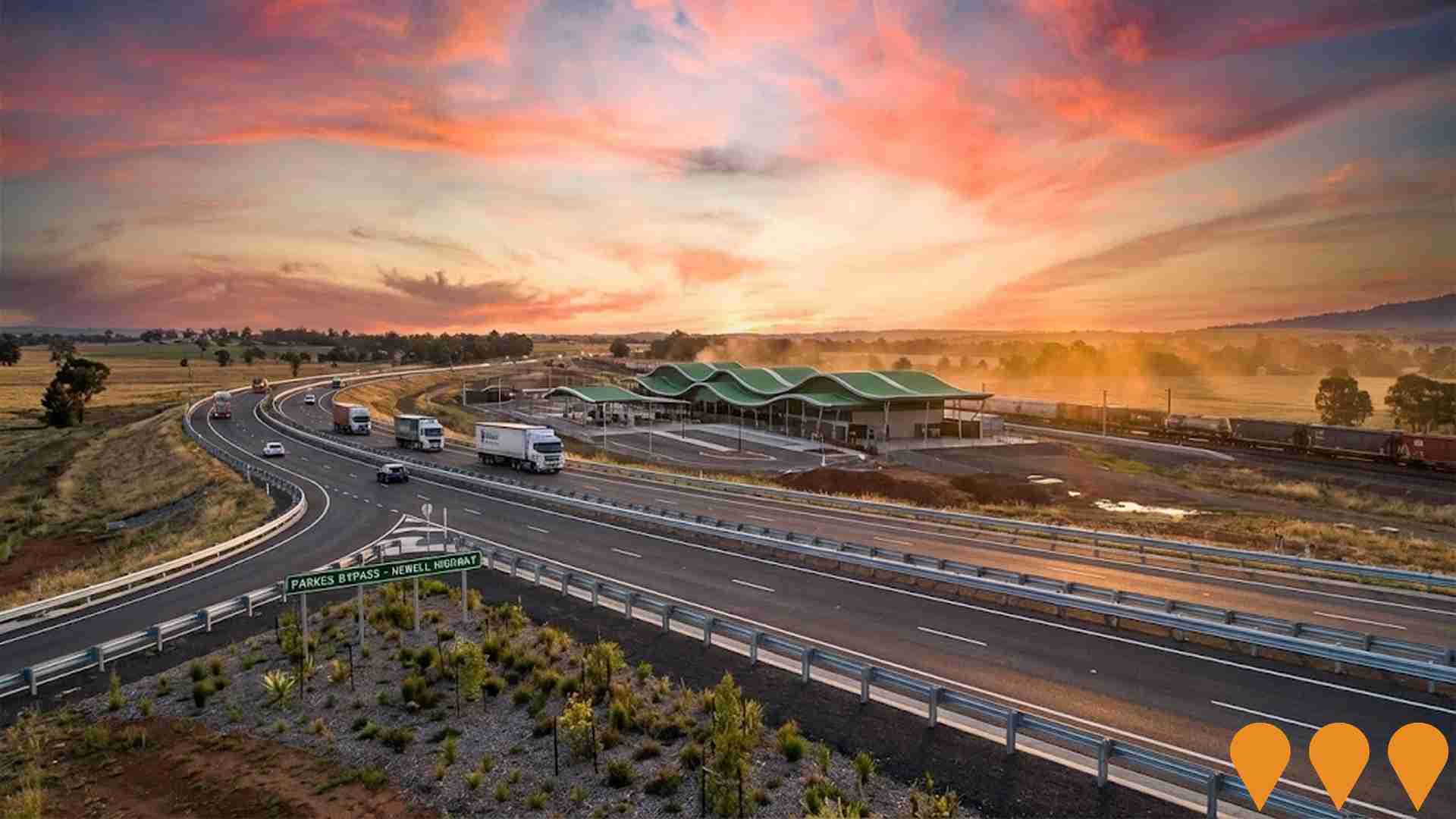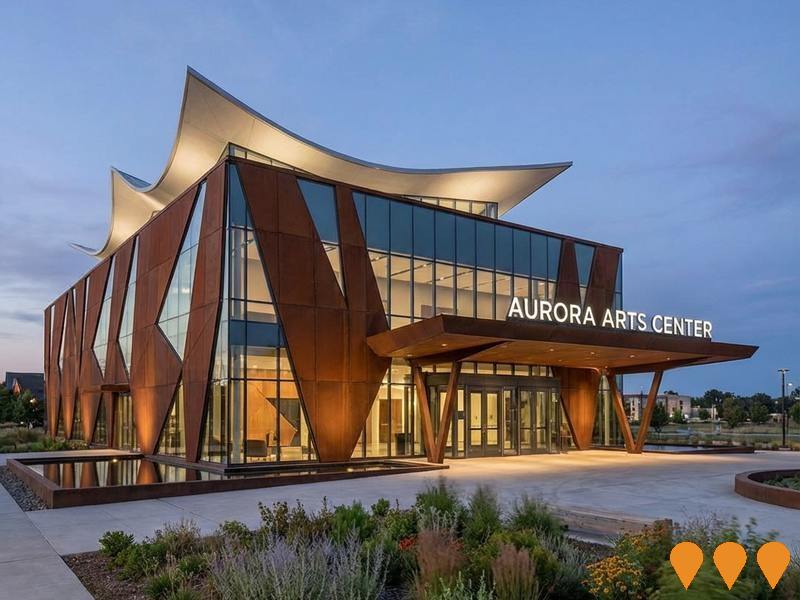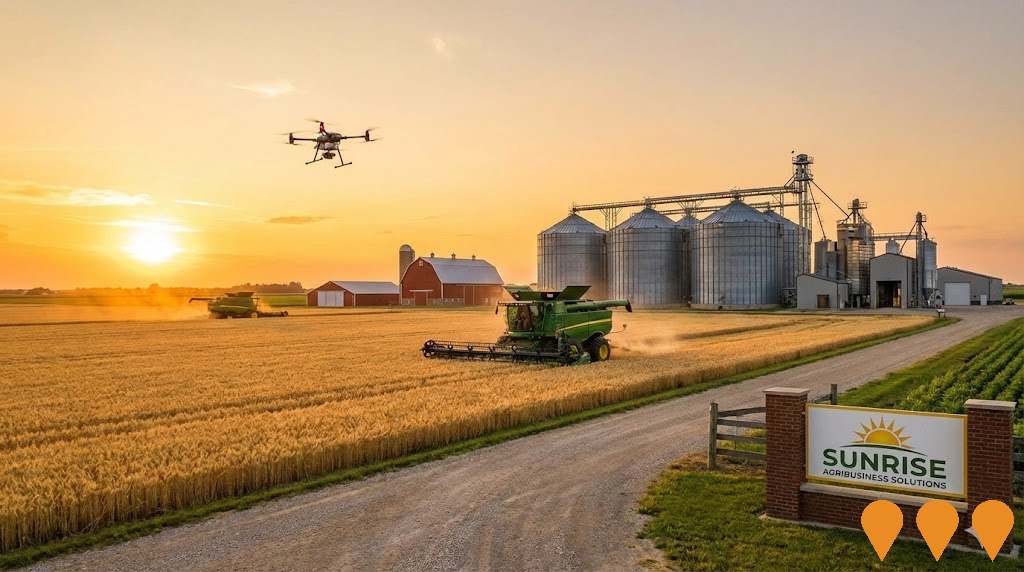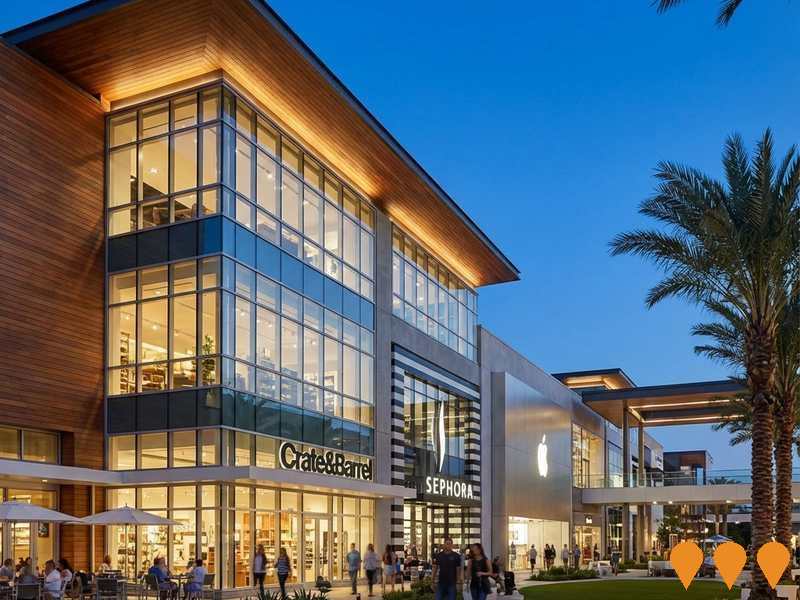Chart Color Schemes
est. as @ -- *
ABS ERP | -- people | --
2021 Census | -- people
Sales Activity
Curious about local property values? Filter the chart to assess the volume and appreciation (including resales) trends and regional comparisons, or scroll to the map below view this information at an individual property level.
Find a Recent Sale
Sales Detail
Population
Parkes is positioned among the lower quartile of areas assessed nationally for population growth based on AreaSearch's assessment of recent, and medium term trends
Parkes' NSW population was 10,919 as of the 2021 Census. By Nov 2025, it is estimated at around 11,052, an increase of 133 people (1.2%). This growth is inferred from ABS data: Parkes' estimated resident population was 11,026 in June 2024, with 85 validated new addresses added since the Census date. The population density is approximately 47 persons per square kilometer. Since the 2021 Census, Parkes has shown a growth rate of 1.2%, outpacing the SA3 area's 0.4% growth and demonstrating leadership in regional growth. Overseas migration contributed about 66.1% of overall population gains during recent periods.
AreaSearch uses ABS/Geoscience Australia projections for each SA2 area, released in 2024 with a base year of 2022. For areas not covered by this data, AreaSearch utilises NSW State Government's SA2 level projections from 2022, using 2021 as the base year. Growth rates by age group are applied to all areas for years 2032 to 2041. Based on these projections, Parkes is expected to experience a population increase just below Australia's non-metropolitan median by 2041. The area is projected to expand by 803 persons over the next 17 years, representing a total increase of 6.8%.
Frequently Asked Questions - Population
Development
Residential development activity is lower than average in Parkes according to AreaSearch's national comparison of local real estate markets
Parkes has averaged approximately 43 new dwelling approvals per year over the past five financial years, totalling 215 homes. As of FY-26, three approvals have been recorded. Despite population decline in the area, housing supply has remained adequate relative to demand, resulting in a balanced market with good buyer choice. New homes are being built at an average expected construction cost value of $367,000.
This financial year, $38.0 million in commercial approvals have been registered, indicating robust local business investment. Compared to the rest of NSW, Parkes shows moderately higher building activity, with 38.0% above the regional average per person over the five-year period. This has preserved reasonable buyer options while sustaining existing property demand. New building activity comprises 64.0% detached dwellings and 36.0% medium and high-density housing, expanding the range of medium-density options and creating a mix of opportunities across price brackets.
This marks a significant shift from existing housing patterns, which are currently 88.0% houses, suggesting diminishing developable land availability and responding to evolving lifestyle preferences and housing affordability needs. The location has approximately 293 people per dwelling approval, indicating a low density market. Looking ahead, Parkes is expected to grow by 751 residents through to 2041. At current development rates, new housing supply should comfortably meet demand, providing good conditions for buyers and potentially supporting growth beyond current population projections.
Frequently Asked Questions - Development
Infrastructure
Parkes has limited levels of nearby infrastructure activity, ranking in the 17thth percentile nationally
AreaSearch has identified 16 projects that could impact the area significantly. Key projects include Parkes Special Activation Precinct, Parkes-Peak Hill Water Supply Project (2021-2023), Parkes Parks and Recreation Irrigation Upgrades (commencing Q2 2022), and Parkes National Logistics Hub Infrastructure Extension (scheduled for completion in late 2024). The following list details those projects likely to be most relevant.
Professional plan users can use the search below to filter and access additional projects.
INFRASTRUCTURE SEARCH
 Denotes AI-based impression for illustrative purposes only, not to be taken as definitive under any circumstances. Please follow links and conduct other investigations from the project's source for actual imagery. Developers and project owners wishing us to use original imagery please Contact Us and we will do so.
Denotes AI-based impression for illustrative purposes only, not to be taken as definitive under any circumstances. Please follow links and conduct other investigations from the project's source for actual imagery. Developers and project owners wishing us to use original imagery please Contact Us and we will do so.
Frequently Asked Questions - Infrastructure
Parkes Hospital (Lachlan Health Service)
NSW Government delivered a $72.8 million modern hospital for Parkes at a new site, opened on 24 November 2015. The facility provides a 24-hour emergency department, medical imaging, ambulatory care, inpatient units, chemotherapy and surgical services, with maternity and birthing suites. It serves Parkes and surrounding communities within the Western NSW Local Health District.
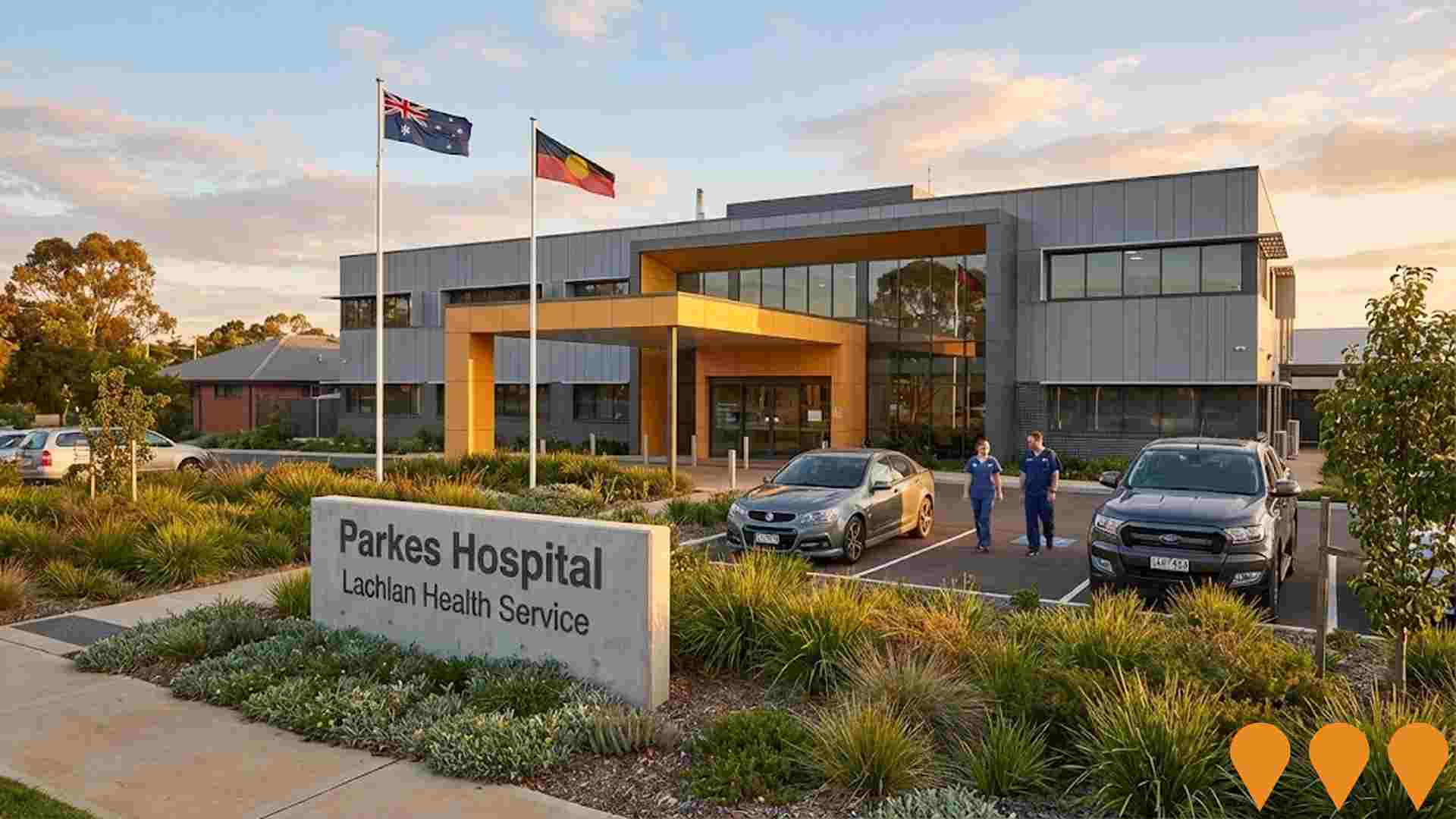
Parkes Special Activation Precinct
A 4,800 hectare eco-industrial precinct at the junction of Australia's two rail spines (Inland Rail and Trans-Australian Railway), aiming to become the nation's largest inland freight and logistics hub. The project is currently in the delivery phase, led by the Regional Growth NSW Development Corporation. Enabling works are underway, including a $126 million contract for the upgrade of 7.3km of Brolgan Road, construction of two rail overpass bridges, and new supporting utilities (water, sewer, electricity, gas, telecommunications). The precinct is designed as Australia's first UNIDO Eco-Industrial Park, focusing on sustainability and circular economy principles. Key anchor tenants include Brightmark, Pet Care Kitchen, and Stevens Group (developing the BP Highway Service Centre). The project is expected to create up to 3,000 jobs across logistics, manufacturing, recycling, and data centres.
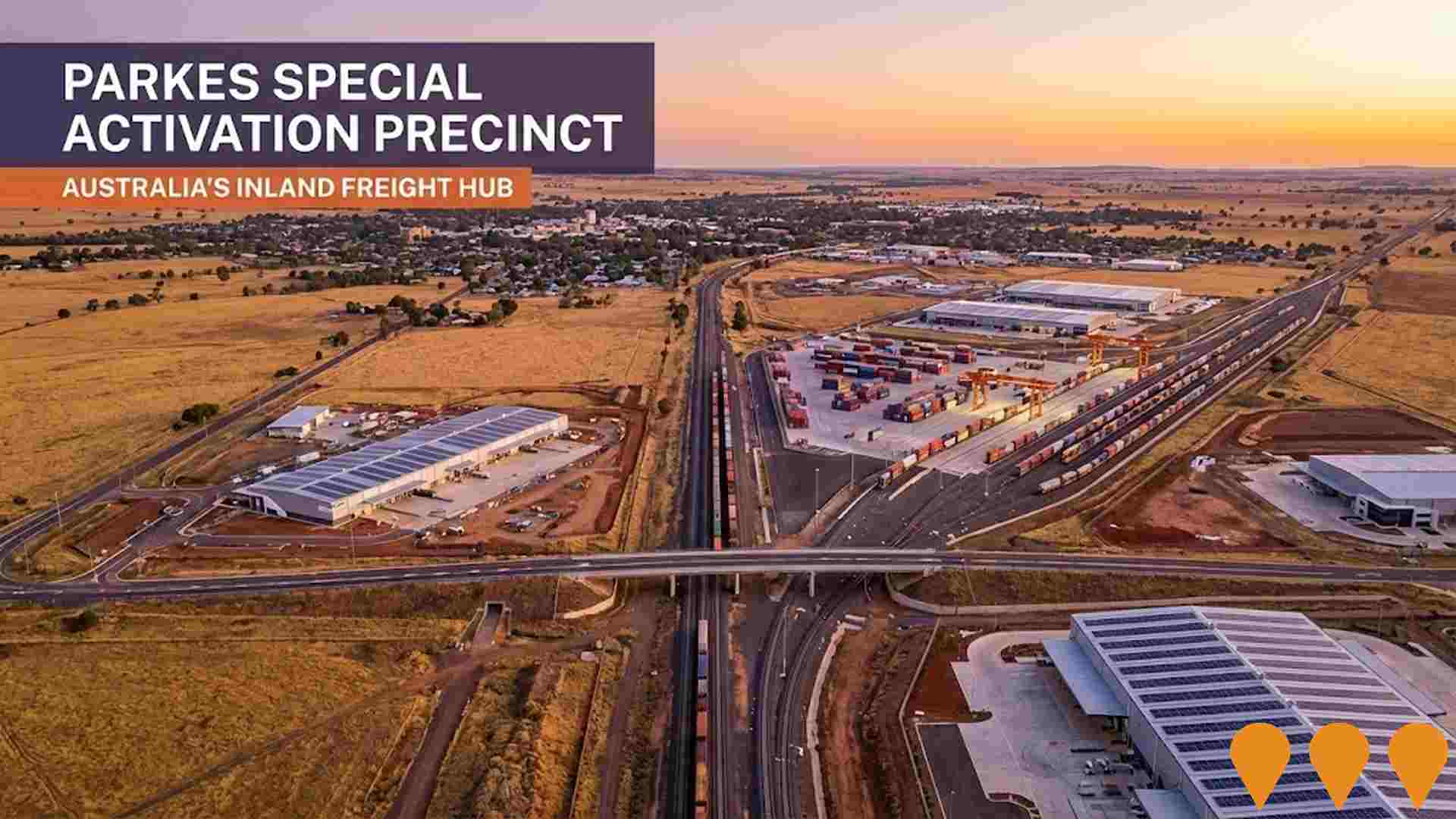
Middleton Urban Masterplan
Comprehensive urban masterplan for residential expansion in southern Parkes, supporting approximately 500 new residential lots with infrastructure for water, sewer, stormwater, transport, and open space. Includes rezoning from R5 Large Lot Residential to R1 General Residential, coordinated staging approach for sustainable growth, and integration with Parkes Hospital and existing community facilities.
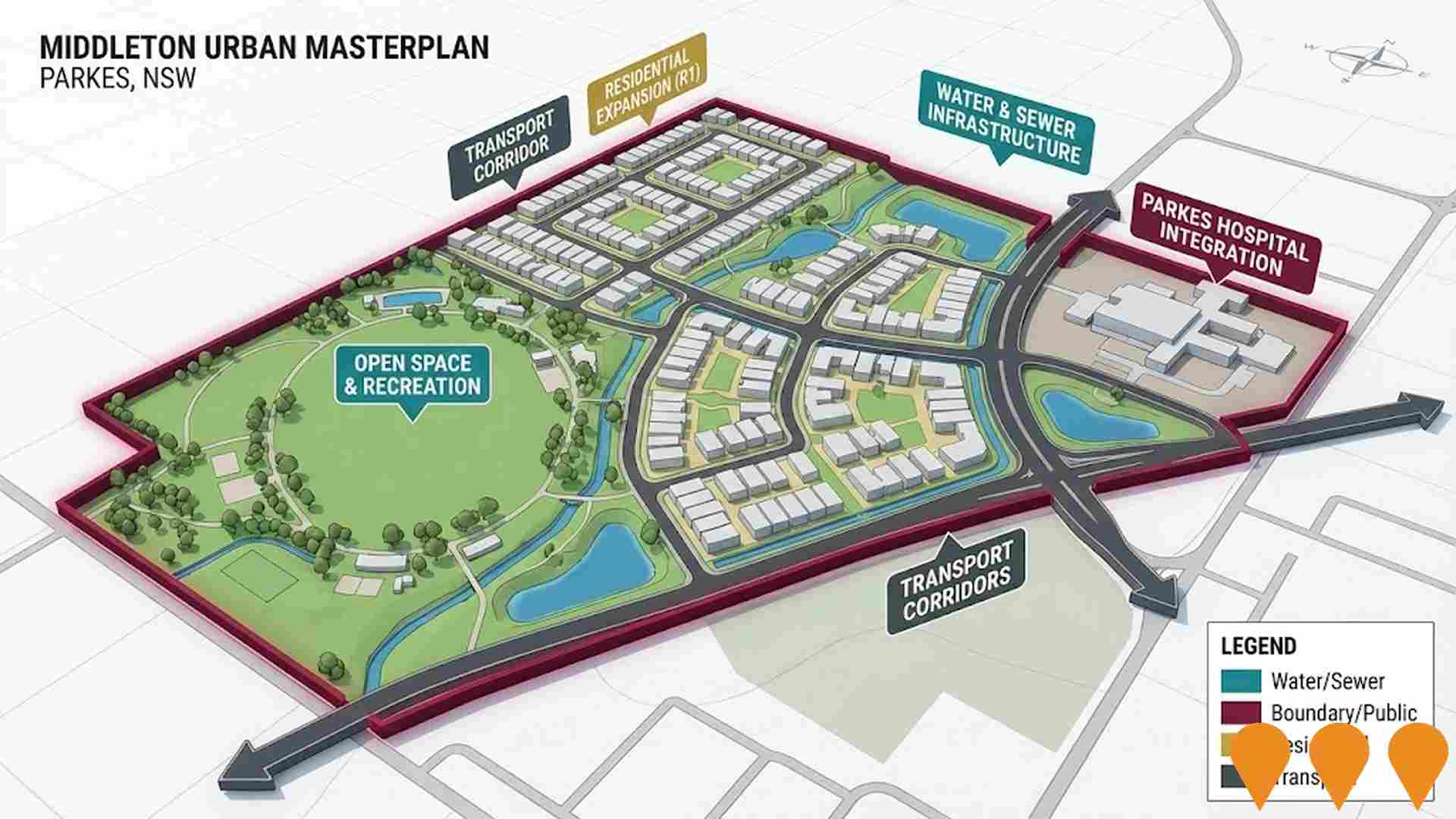
East Parkes Master Plan and Servicing Strategy
Master plan to guide development of liveable neighbourhoods with comprehensive infrastructure servicing for wastewater, water, stormwater, electricity, and natural assets. The strategy incorporates updated flood modelling from the 2022 flood event and will support up to 3,480 new dwellings in the East Parkes residential growth area. Project funded by NSW Government's Regional Housing Strategic Planning Fund and expected to be completed by mid-2026.
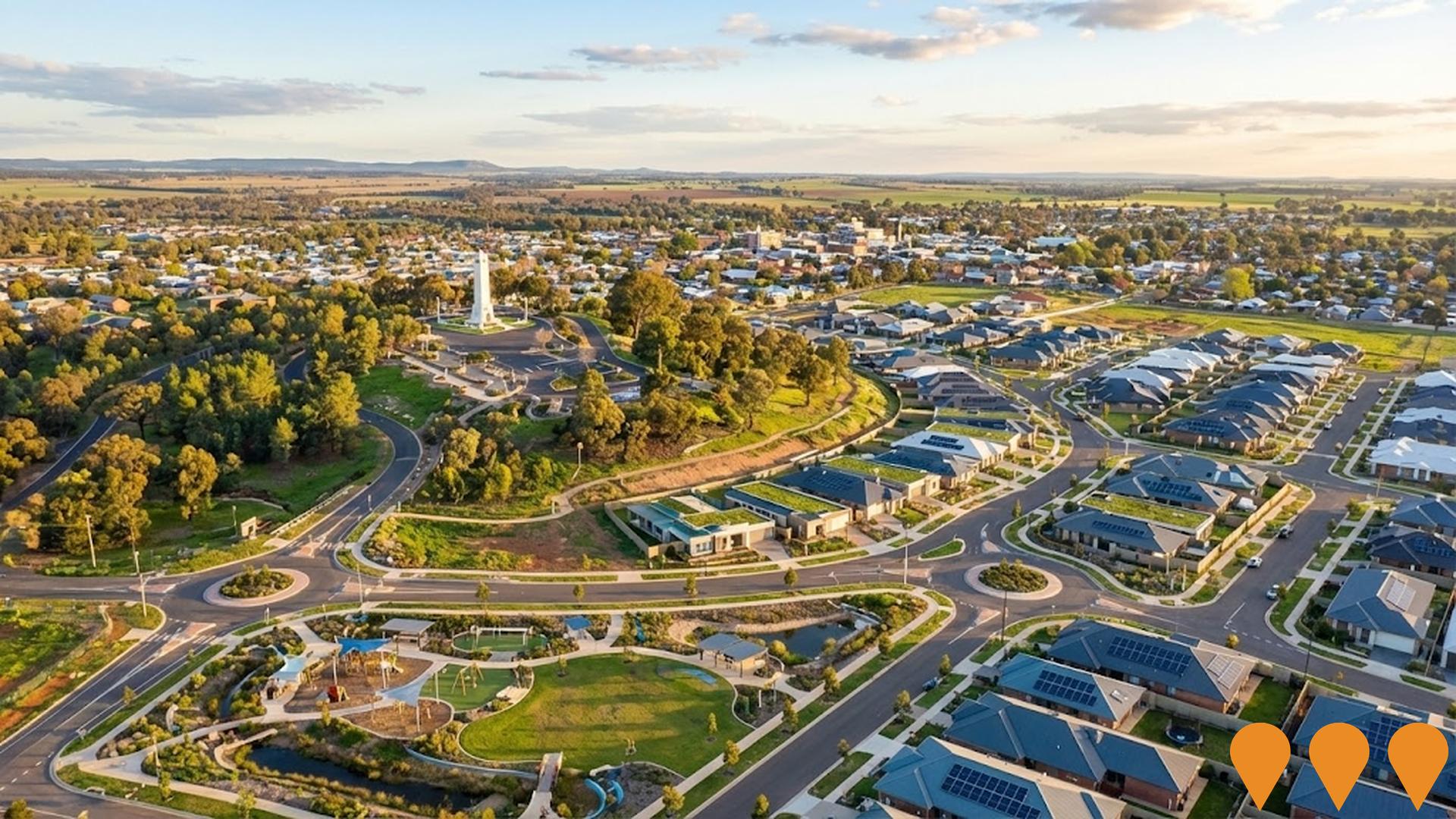
Pacific National Parkes Logistics Terminal
A $35 million intermodal freight terminal on 365 hectares within the National Logistics Hub. Capacity to process 450,000 containers annually with 1,800-metre rail sidings for double-stacked containers. Operational since 2019, employs 100 people. Australia's largest rail freight operator Pacific National's terminal launched operations in October 2019.
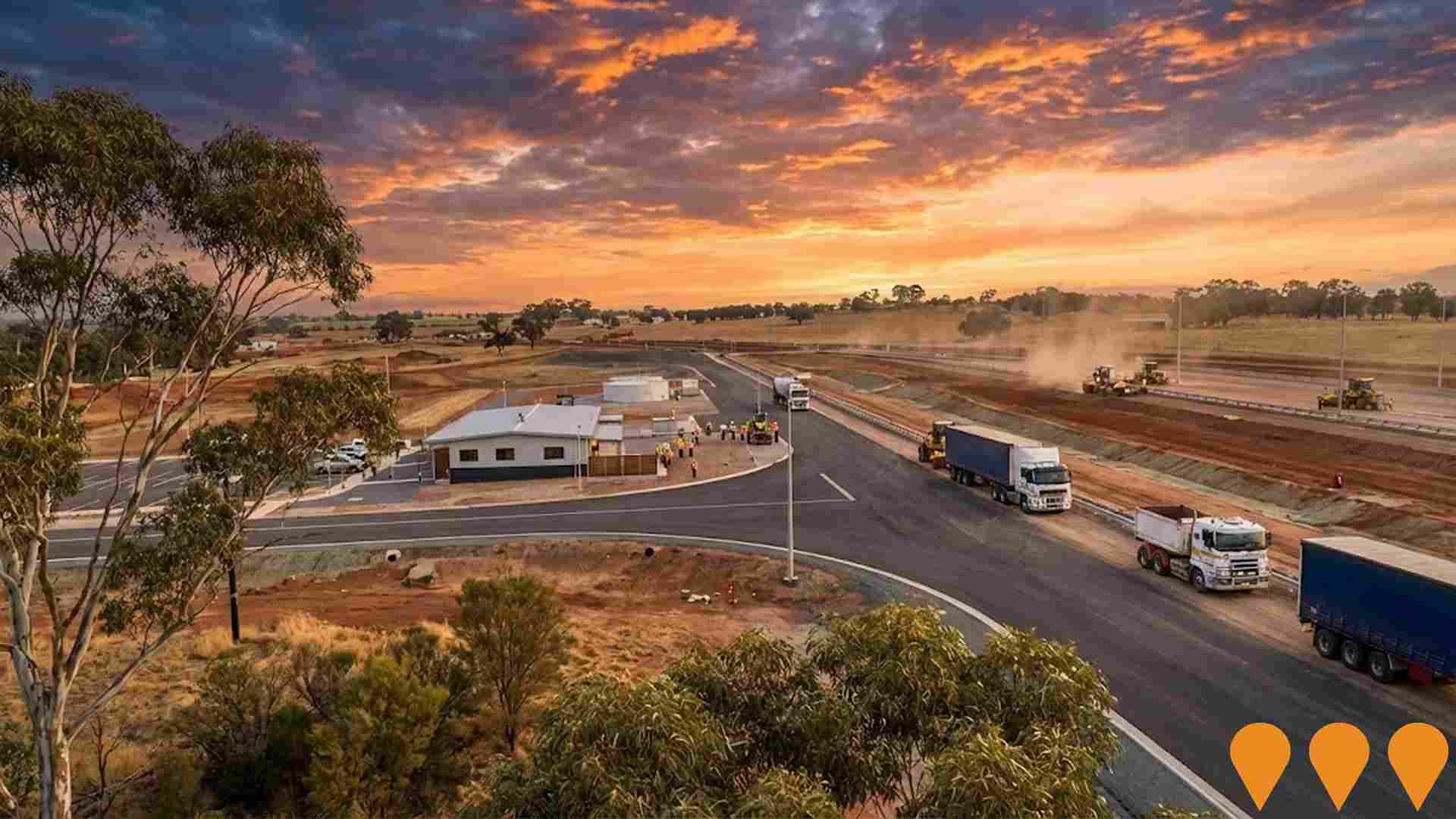
Parkes-Peak Hill Water Supply Project
A $61.7 million water infrastructure project including 39 kilometres of new pipelines, two new pump stations, upgraded Lachlan River pump station, new pre-treatment plant and raw water storage lagoon. Will more than double Parkes' current transfer capacity.
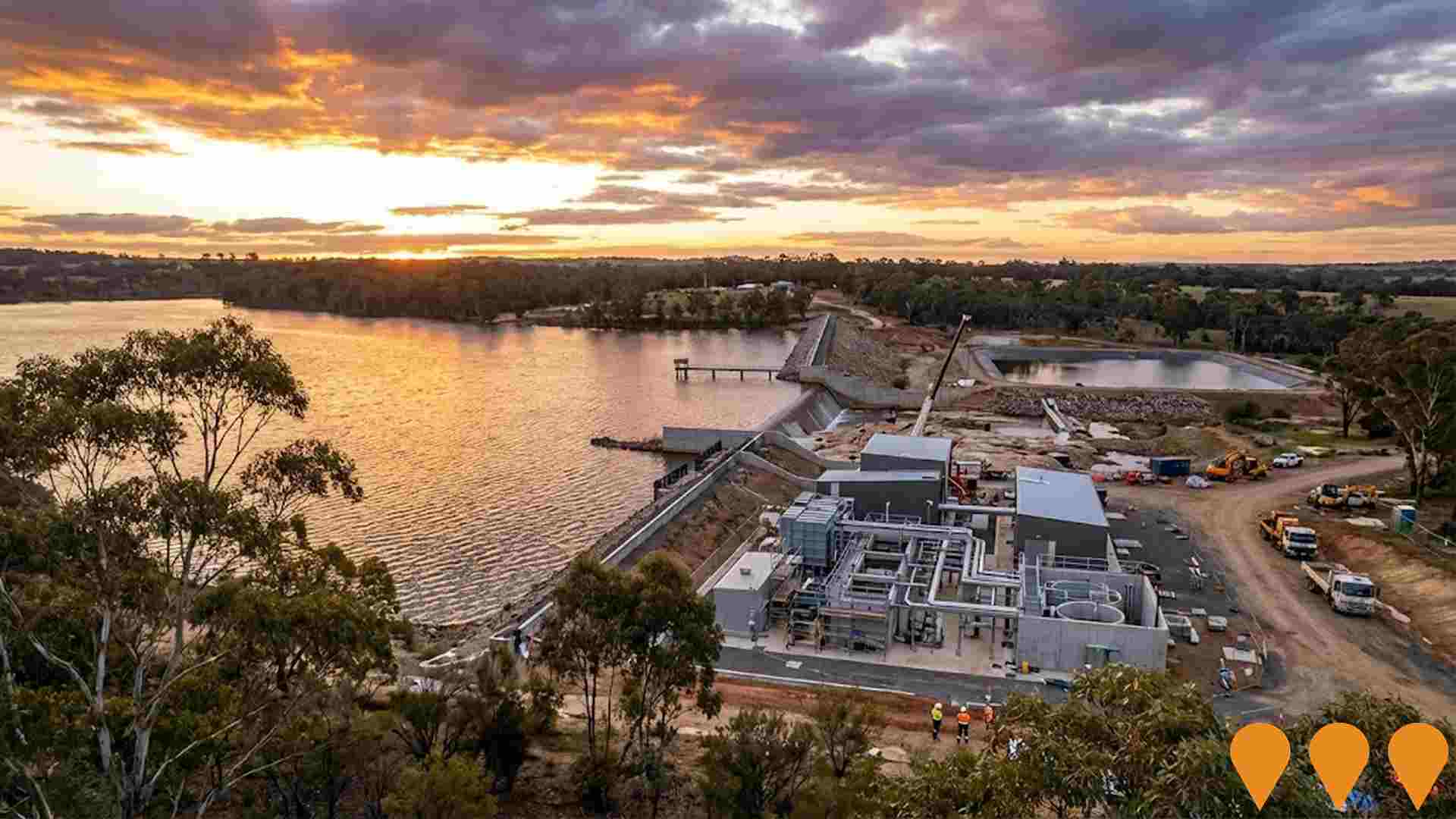
Parkes National Logistics Hub Infrastructure Extension
Infrastructure extension to deliver crucial service extensions to facilitate and enable developments in the National Logistics Hub area. Part of the broader 600-hectare logistics precinct supporting multiple anchor tenants including SCT Logistics and Linfox. Government infrastructure supporting the broader logistics ecosystem.
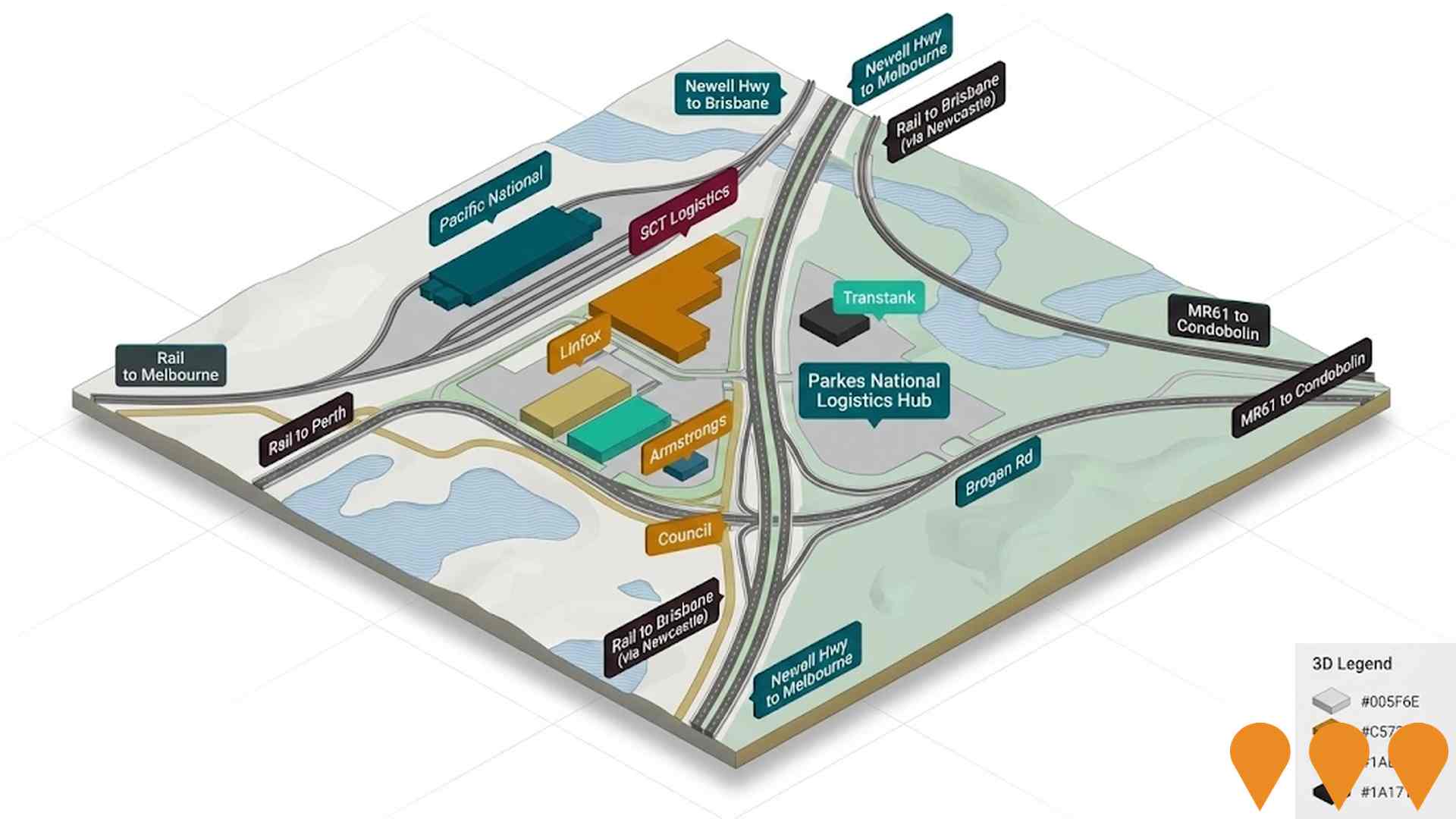
Parkes Wetlands (former STP ponds)
Council-led transformation of the decommissioned Parkes Sewage Treatment Plant maturation ponds on Akuna Road into the Parkes Wetlands. Stage 1 earthworks were completed in 2023, with recycled water introduced to create a biodiverse, hydrologically complex wetland. Stage 2 (walking track) targeted mid-2024. In 2024, the project secured additional Federal Growing Regions Program funding and NSW Local Small Communities funding to deliver boardwalks, viewing platforms, all-abilities bird hides, revegetation, signage and public art. Works are ongoing through 2025.

Employment
Despite maintaining a low unemployment rate of 3.0%, Parkes has experienced recent job losses, resulting in a below average employment performance ranking when compared nationally
Parkes, New South Wales, has a balanced workforce with white and blue collar jobs, featuring strong representation from essential services sectors. The unemployment rate in Parkes is 3.0%.
As of June 2025, there are 5,709 residents employed, with an unemployment rate of 0.7% lower than the Rest of NSW's rate of 3.7%. Workforce participation in Parkes is similar to the Rest of NSW at 56.4%. Key industries for employment among residents include health care & social assistance, retail trade, and mining. Parkes has a particularly strong specialization in mining, with an employment share 3.9 times the regional level.
Conversely, health care & social assistance shows lower representation at 13.2% compared to the regional average of 16.9%. The area appears to offer limited local employment opportunities, as indicated by the difference between Census working population and resident population. In a 12-month period ending in June 2025, Parkes' labour force decreased by 2.4%, while employment declined by 3.7%, resulting in an unemployment rate increase of 1.2 percentage points. This contrasts with Rest of NSW, where employment contracted by 0.1%, the labour force grew by 0.3%, and unemployment rose by 0.4 percentage points. Jobs and Skills Australia's national employment forecasts from May 2025 suggest potential future demand within Parkes. These projections estimate national employment growth at 6.6% over five years and 13.7% over ten years, with varying rates between industry sectors. Applying these projections to Parkes' employment mix suggests local growth of approximately 5.7% over five years and 12.4% over ten years.
Frequently Asked Questions - Employment
Income
Income levels sit below national averages according to AreaSearch assessment
Parkes's median income among taxpayers was $51,042 in financial year 2022. The average income stood at $63,490 during the same period. These figures compare to Rest of NSW's median and average incomes of $49,459 and $62,998 respectively. By September 2025, based on a Wage Price Index growth of 12.61%, Parkes's estimated median income would be approximately $57,478 and the average income would be around $71,496. Census data shows that household, family, and personal incomes in Parkes rank modestly, between the 28th and 34th percentiles. Income distribution indicates that 30.2% of Parkes' community earns between $1,500 and $2,999 (3,337 individuals), which is consistent with broader trends across the surrounding region showing 29.9% in the same category. Housing costs are manageable, with 86.8% retained, but disposable income sits below average at the 32nd percentile.
Frequently Asked Questions - Income
Housing
Parkes is characterized by a predominantly suburban housing profile, with a higher proportion of rental properties than the broader region
In Parkes, as per the latest Census evaluation, 88.5% of dwellings were houses, with the remaining 11.4% consisting of semi-detached homes, apartments, and other types of dwellings. This is compared to Non-Metro NSW's figures of 92.0% houses and 8.0% other dwellings. Home ownership in Parkes stood at 34.9%, with mortgaged properties accounting for 34.1% and rented dwellings making up 31.0%. The median monthly mortgage repayment in the area was $1,300, higher than Non-Metro NSW's average of $1,200. The median weekly rent in Parkes was recorded at $260, compared to Non-Metro NSW's figure of $220. Nationally, Parkes's mortgage repayments were significantly lower than the Australian average of $1,863, while rents were substantially below the national figure of $375.
Frequently Asked Questions - Housing
Household Composition
Parkes features high concentrations of lone person households, with a higher-than-average median household size
Family households constitute 66.6% of all households, including 25.5% couples with children, 27.2% couples without children, and 12.9% single parent families. Non-family households comprise the remaining 33.4%, with lone person households at 30.9% and group households making up 2.6% of the total. The median household size is 2.4 people, which is larger than the Rest of NSW average of 2.3.
Frequently Asked Questions - Households
Local Schools & Education
Parkes faces educational challenges, with performance metrics placing it in the bottom quartile of areas assessed nationally
The university qualification rate in the area is 14.3%, significantly lower than NSW's average of 32.2%. Bachelor degrees are most common at 10.4%, followed by postgraduate qualifications (2.2%) and graduate diplomas (1.7%). Vocational credentials are held by 39.7% of residents aged 15+, with advanced diplomas at 8.1% and certificates at 31.6%. Educational participation is high, with 28.9% currently enrolled in formal education: 11.4% in primary, 9.0% in secondary, and 2.0% in tertiary education.
Six schools operate within Parkes, educating approximately 1,858 students. The school mix includes four primary, one secondary, and one K-12 school.
Frequently Asked Questions - Education
Schools Detail
Nearby Services & Amenities
Transport
Transport servicing is moderate compared to other areas nationally based on assessment of service frequency, route connectivity and accessibility
Parkes has 508 active public transport stops, serving a mix of train and bus services. These stops are covered by 40 different routes, offering a total of 613 weekly passenger trips. The average distance to the nearest stop for residents is 125 meters.
Across all routes, there are an average of 87 daily trips, which translates to roughly one weekly trip per individual stop.
Frequently Asked Questions - Transport
Transport Stops Detail
Health
Health performance in Parkes is well below average with prevalence of common health conditions notable across both younger and older age cohorts
Parkes faces significant health challenges. Common health conditions are prevalent across both younger and older age groups.
Private health cover stands at approximately 51% of Parkes' total population (~5,658 people), slightly lower than the average SA2 area's 48.3%. The most common medical conditions are arthritis and asthma, affecting 9.7% and 9.7% of residents respectively. 62.8% of residents report no medical ailments, compared to 62.4% across Rest of NSW. Parkes has 19.9% of residents aged 65 and over (2,199 people), lower than the 23.8% in Rest of NSW. Health outcomes among seniors present challenges broadly aligned with the general population's health profile.
Frequently Asked Questions - Health
Cultural Diversity
The latest Census data sees Parkes placing among the least culturally diverse areas in the country when compared across a range of language and cultural background related metrics
Parkes has a cultural diversity index below the average, with 90.8% of its population being Australian citizens, 93.5% born in Australia, and 95.8% speaking English only at home. Christianity is the predominant religion in Parkes, making up 68.2%, compared to 70.4% across the Rest of NSW. The top three ancestry groups are Australian (34.0%), English (31.1%), and Australian Aboriginal (9.1%).
Notably, Irish ancestry is overrepresented at 8.0% in Parkes compared to 8.9% regionally, while French is at 0.4% versus 0.3%, and South African is at 0.3% versus 0.2%.
Frequently Asked Questions - Diversity
Age
Parkes's population is slightly older than the national pattern
The median age in Parkes is 39 years, which is significantly lower than Rest of NSW's average of 43 but essentially aligned with Australia's median age of 38 years. Compared to Rest of NSW, Parkes has a higher proportion of residents aged 25-34 (13.5%) but fewer residents aged 65-74 (10.3%). According to the 2021 Census, the 25 to 34 age group increased from 11.9% to 13.5% of Parkes' population. Conversely, the 5 to 14 age group decreased from 14.2% to 13.2%. By 2041, demographic projections indicate significant shifts in Parkes' age structure. The 25 to 34 age group is expected to grow by 23%, reaching 1,835 people from the current 1,489. Conversely, the 65 to 74 and 55 to 64 age groups are projected to experience population declines.
